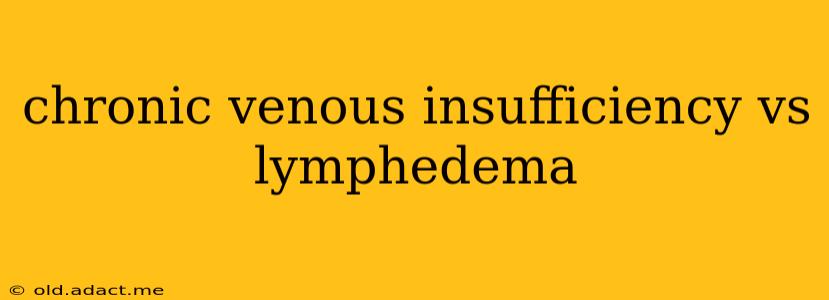Chronic venous insufficiency (CVI) and lymphedema are both conditions that cause swelling in the legs and ankles, leading to many people confusing the two. However, they are distinct conditions with different underlying causes, symptoms, and treatment approaches. Understanding the key differences is crucial for proper diagnosis and effective management. This article will explore the nuances of each condition, highlighting their similarities and differences to aid in better comprehension.
What is Chronic Venous Insufficiency (CVI)?
Chronic venous insufficiency is a condition characterized by insufficient venous return from the legs and feet to the heart. This means the veins, particularly the superficial veins, are unable to effectively pump blood back up against gravity. The most common cause is venous valve dysfunction, where the one-way valves in the veins malfunction, allowing blood to pool in the legs. This pooling of blood leads to increased pressure within the veins, causing a range of symptoms.
Symptoms of CVI:
- Leg swelling (edema): Often worse at the end of the day or after prolonged standing.
- Leg pain and heaviness: Aching, cramping, or tiredness in the legs, especially after prolonged standing or sitting.
- Skin changes: These can include discoloration (brownish pigmentation around the ankles), thickening of the skin, and varicose veins.
- Leg ulcers: These are open sores that can be difficult to heal. They usually occur on the lower leg, often around the ankle.
What is Lymphedema?
Lymphedema is a condition characterized by swelling caused by a blockage in the lymphatic system. The lymphatic system is a network of vessels and nodes that plays a vital role in removing waste products and excess fluid from the body's tissues. When the lymphatic system is blocked, fluid accumulates in the tissues, leading to swelling. This blockage can be caused by various factors, including:
- Surgery: Removal of lymph nodes during cancer treatment is a common cause.
- Radiation therapy: Damage to lymph nodes as a result of cancer treatment.
- Infection: Infections can sometimes damage the lymphatic system.
- Congenital conditions: Some people are born with abnormalities in their lymphatic system.
Symptoms of Lymphedema:
- Swelling: This swelling is typically non-pitting, meaning that when you press on the swollen area, the indentation doesn't remain.
- Feeling of tightness or heaviness: Similar to CVI, but can be more pronounced in lymphedema.
- Restricted range of motion: The swelling can make it difficult to bend or move the affected limb.
- Recurring infections: The buildup of fluid can increase the risk of infections.
- Skin changes: The skin may become thickened and hardened (fibrosis).
Chronic Venous Insufficiency vs. Lymphedema: Key Differences Summarized
| Feature | Chronic Venous Insufficiency (CVI) | Lymphedema |
|---|---|---|
| Cause | Venous valve dysfunction, impaired venous return | Lymphatic system blockage |
| Swelling | Often pitting edema, worse at end of day | Typically non-pitting edema |
| Pain | Common, aching, heaviness, cramping | May be present, but often less pronounced than CVI |
| Skin Changes | Brownish pigmentation, thickening, varicose veins, ulcers | Thickening, hardening (fibrosis) |
| Underlying System | Venous system | Lymphatic system |
How are CVI and Lymphedema Diagnosed?
Diagnosis involves a physical examination, detailed medical history, and possibly some imaging tests like ultrasound or lymphoscintigraphy. A thorough evaluation helps differentiate between the two conditions.
What are the Treatments for CVI and Lymphedema?
Treatments for both conditions focus on managing symptoms and preventing complications. These may include:
- Compression therapy: Special stockings or bandages to reduce swelling and improve blood flow.
- Elevation: Keeping the legs elevated to reduce swelling.
- Exercise: Regular exercise helps improve circulation and lymphatic drainage.
- Medication: Some medications can help reduce swelling and pain.
- Surgery: In severe cases, surgery may be necessary to correct venous valve dysfunction (CVI) or improve lymphatic drainage (Lymphedema).
- Manual Lymphatic Drainage (MLD): A specialized massage technique to help move lymphatic fluid. This is particularly important for Lymphedema.
Can you have both CVI and Lymphedema?
While rare, it's possible to have both CVI and lymphedema simultaneously. The underlying causes are distinct, but their overlapping symptoms can make diagnosis challenging. A comprehensive evaluation by a healthcare professional is crucial for accurate diagnosis and appropriate management.
What are the long-term effects of CVI and Lymphedema?
Left untreated, both conditions can lead to significant complications, including skin infections, leg ulcers, and decreased mobility. Early diagnosis and treatment are key to minimizing long-term effects and improving quality of life.
This information is intended for educational purposes only and does not constitute medical advice. Always consult with a healthcare professional for diagnosis and treatment of any medical condition.
